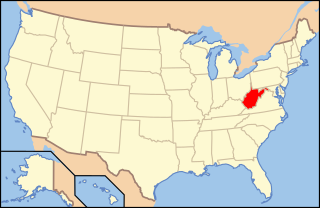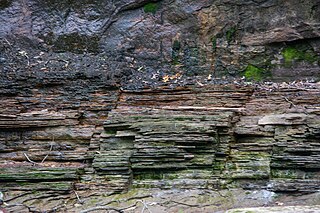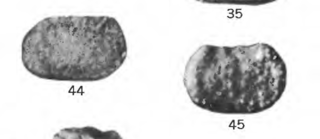Related Research Articles

Bellerophon is a genus of extinct paleozoic marine molluscs of uncertain position in the family Bellerophontidae.

Tabulata, commonly known as tabulate corals, are an order of extinct forms of coral. They are almost always colonial, forming colonies of individual hexagonal cells known as corallites defined by a skeleton of calcite, similar in appearance to a honeycomb. Adjacent cells are joined by small pores. Their distinguishing feature is their well-developed horizontal internal partitions (tabulae) within each cell, but reduced or absent vertical internal partitions. They are usually smaller than rugose corals, but vary considerably in shape, from flat to conical to spherical.

The Marcellus Formation or the Marcellus Shale is a Middle Devonian age unit of sedimentary rock found in eastern North America. Named for a distinctive outcrop near the village of Marcellus, New York, in the United States, it extends throughout much of the Appalachian Basin.

Terebratula is a modern genus of brachiopods with a fossil record dating back to the Late Devonian. These brachiopods are stationary epifaunal suspension feeders and have a worldwide distribution.

Atrypa is a genus of brachiopod with shells round to short egg-shaped, covered with many fine radial ridges, that split further out and growth lines perpendicular to the costae and 2-3 times wider spaced. The pedunculate valve is a little convex, but tends to level out or even become slightly concave toward the anterior margin. The brachial valve is highly convex. There is no interarea in either valve. Atrypa was a cosmopolitan and occurred from the late Lower Silurian (Telychian) to the early Upper Devonian (Frasnian). Other sources expand the range from the Late Ordovician to Carboniferous, approximately from 449 to 336 Ma. A proposed new species, A. harrisi, was found in the trilobite-rich Floresta Formation in Boyacá, Colombia.

The Bedford Shale is a shale geologic formation in the states of Ohio, Michigan, Pennsylvania, Kentucky, West Virginia, and Virginia in the United States.

The Devonian Jeffersonville Limestone is a mapped bedrock unit in Indiana and Kentucky. It is highly fossiliferous.

Syringopora is an extinct genus of phaceloid tabulate coral. It has been found in rocks ranging in age from the Ordovician to the Permian, although it was most widespread during the Silurian, Devonian, and Carboniferous periods. Among other places, it has been found in the Columbus Limestone in Ohio, and in the Spring Branch Member of the Lecompton Limestone in Kansas.

Paleontology in West Virginia refers to paleontological research occurring within or conducted by people from the U.S. state of West Virginia. West Virginia's fossil record begins in the Cambrian. From that time through the rest of the early Paleozoic, the state was at least partially submerged under a shallow sea. The Paleozoic seas of West Virginia were home to creatures like corals, eurypterids, graptolites, nautiloids, and trilobites at varying times. During the Carboniferous period, the sea was replaced by lushly vegetated coastal swamps. West Virginia is an excellent source of fossil plants due to these deposits. These swamps were home to amphibians. A gap in the local rock record spans from the Permian to the end of the Cenozoic. West Virginia was never the site of glacial activity during the Ice Age, but the state was home to creatures like mammoths, mastodons, and giant ground sloths. One local ground sloth, Megalonyx jeffersonii, was subject to the scholarly investigations of Thomas Jefferson, who misinterpreted the large-clawed remains as belonging to a lion-like predator. In 2008, this species was designated the West Virginia state fossil.

Paleontology in Ohio refers to paleontological research occurring within or conducted by people from the U.S. state of Ohio. Ohio is well known for having a great quantity and diversity of fossils preserved in its rocks. The state's fossil record begins early in the Paleozoic era, during the Cambrian period. Ohio was generally covered by seawater from that time on through the rest of the early Paleozoic. Local invertebrates included brachiopods, cephalopods, coral, graptolites, and trilobites. Vertebrates included bony fishes and sharks. The first land plants in the state grew during the Devonian. During the Carboniferous, Ohio became a more terrestrial environment with an increased diversity of plants that formed expansive swampy deltas. Amphibians and reptiles began to inhabit the state at this time, and remained present into the ensuing Permian. A gap in the local rock record spans from this point until the start of the Pleistocene. During the Ice Age, Ohio was home to giant beavers, humans, mammoths, and mastodons. Paleo-Indians collected fossils that were later incorporated into their mounds. Ohio has been the birthplace of many world famous paleontologists, like Charles Schuchert. Many significant fossils curated by museums in Europe and the United States were found in Ohio. Major local fossil discoveries include the 1965 discovery of more than 50,000 Devonian fish fossils in Cuyahoga County. The Ordovician trilobite Isotelus maximus is the Ohio state invertebrate fossil.

Paleontology in Texas refers to paleontological research occurring within or conducted by people from the U.S. state of Texas. Author Marian Murray has remarked that "Texas is as big for fossils as it is for everything else." Some of the most important fossil finds in United States history have come from Texas. Fossils can be found throughout most of the state. The fossil record of Texas spans almost the entire geologic column from Precambrian to Pleistocene. Shark teeth are probably the state's most common fossil. During the early Paleozoic era Texas was covered by a sea that would later be home to creatures like brachiopods, cephalopods, graptolites, and trilobites. Little is known about the state's Devonian and early Carboniferous life. However, evidence indicates that during the late Carboniferous the state was home to marine life, land plants and early reptiles. During the Permian, the seas largely shrank away, but nevertheless coral reefs formed in the state. The rest of Texas was a coastal plain inhabited by early relatives of mammals like Dimetrodon and Edaphosaurus. During the Triassic, a great river system formed in the state that was inhabited by crocodile-like phytosaurs. Little is known about Jurassic Texas, but there are fossil aquatic invertebrates of this age like ammonites in the state. During the Early Cretaceous local large sauropods and theropods left a great abundance of footprints. Later in the Cretaceous, the state was covered by the Western Interior Seaway and home to creatures like mosasaurs, plesiosaurs, and few icthyosaurs. Early Cenozoic Texas still contained areas covered in seawater where invertebrates and sharks lived. On land the state would come to be home to creatures like glyptodonts, mammoths, mastodons, saber-toothed cats, giant ground sloths, titanotheres, uintatheres, and dire wolves. Archaeological evidence suggests that local Native Americans knew about local fossils. Formally trained scientists were already investigating the state's fossils by the late 1800s. In 1938, a major dinosaur footprint find occurred near Glen Rose. Pleurocoelus was the Texas state dinosaur from 1997 to 2009, when it was replaced by Paluxysaurus jonesi after the Texan fossils once referred to the former species were reclassified to a new genus.

The Bluefield Formation is a geologic formation in West Virginia. It preserves fossils dating back to the Mississippian subperiod of the Carboniferous period. Sediments of this age formed along a large marine basin lying in the region of what is now the Appalachian Plateau. The Bluefield Formation is the lowest section of the primarily siliciclastic Mauch Chunk Group, underlying the Stony Gap Sandstone Member of the Hinton Formation and overlying the limestone-rich Greenbrier Group.

The Cleveland Shale, also referred to as the Cleveland Member, is a shale geologic formation in the eastern United States.
Betty Kellett Nadeau (1906-?) was an American paleontologist and micro-paleontologist who studied Palaeozoic ostracod. Numerous marine species were discovered due to the work she had done throughout her fruitful career. This work is evident to the genus Bekena named after her.
This list of fossil arthropods described in 2018 is a list of new taxa of trilobites, fossil insects, crustaceans, arachnids, and other fossil arthropods of every kind that were described during the year 2018, as well as other significant discoveries, and events related to arthropod paleontology that are scheduled to occur in the year 2018.
Leiorhynchus is an extinct genus of brachiopod belonging to the order Rhynchonellida and family Leiorhynchidae. Specimens have been found in South America, North America, and Russia in beds of middle Devonian to Mississippian age. The genus may have been adapted to dysaerobic environments, colonizing areas of reduced oxygen concentrations rich in organic matter. The genus has been used as an index fossil in North America.
Pugnoides is an extinct genus of brachiopod belonging to the order Rhynchonellida and family Petasmariidae. Specimens have been found in Devonian to Permian beds in North America, Asia, Europe, western Australia, New Zealand,and New Zealand. The genus was particularly widespread in the Visean.

Amphissites is an extinct genus of ostracod belonging to the suborder Beyrichicopina and family Amphissitinae. Species belonging to the genus lived from the Devonian to the Permian in Europe, North America, Australia, and east Asia. The genus were likely deposit-feeders, and may have survived briefly into the Triassic.

Roundyella is an extinct genus of ostracod belonging to the order Leperditellocopida and family Scrobiculidae. Specimens have been found in beds of Devonian to Triassic age in Australia, Asia, Europe, North America, and South America.
References
- 1 2 J. J. Sepkoski Jr. 1998. Rates of speciation in the fossil record. Philosophical Transactions of the Royal Society Biological Sciences 353(1366):315-326
- 1 2 3 4 Moore, R., Lalicker, C., Fischer, A. 1952. Invertebrate Fossils.
- 1 2 Feldman, R. (ed.) 1996. Fossils of Ohio. Ohio Department of Natural Resources, Division of Geological Survey, Bulletin 70. pg. 115–121
- 1 2 3 Moore, R. ed. Treatise on Invertebrate Paleontology. Volume Q. pp.88-94
- ↑ L. E. Stover. 1956. Ostracoda from the Windom Shale (Hamilton) of Western New York. Journal of Paleontology. 30(5):1092-1142
- ↑ R. L. Ellison. 1965. Stratigraphy and Paleontology of the Mahantango Formation in south-central Pennsylvania. Pennsylvania Geological Survey Bulletin.
- ↑ P. Morzadec and D. Brice. 2000. The Devonian of France: a tentative tie with the GSSP of the Devonian stages. 225:115-129